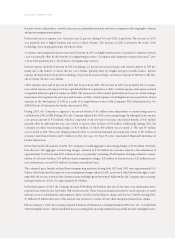American Express 2003 Annual Report Download - page 34
Download and view the complete annual report
Please find page 34 of the 2003 American Express annual report below. You can navigate through the pages in the report by either clicking on the pages listed below, or by using the keyword search tool below to find specific information within the annual report.
duction of new card products, as well as increases in cardmember rewards and services expenses reflecting higher volumes
and greater program participation.
Professional services expense rose 11 percent and 22 percent during 2003 and 2002, respectively. The increase in 2003
was primarily due to higher business and service-related volumes. The increase in 2002 is primarily the result of the
technology outsourcing agreements referenced earlier.
Occupancy and equipment expense increased 5 percent in 2003 as higher amortization of capitalized computer software
costs was partially offset by the benefits of reengineering activities. Occupancy and equipment expense decreased 7 per-
cent in 2002 primarily due to the benefits of reengineering activities.
Interest expense declined 16 percent in 2003 including a 22 percent decrease in charge card interest expense at TRS pri-
marily due to the benefit of a lower effective cost of funds, partially offset by a higher average receivable balance. Interest
expense declined 28 percent in 2002 including a 31 percent decrease in charge card interest expense at TRS due to the ben-
efit of a lower effective cost of funds.
Other expenses increased 11 percent in 2003 and 21 percent in 2002. The increase in 2003 was primarily due to acquisi-
tion-related expenses, the impact of fewer capitalized deferred acquisition cost (DAC)-related expenses and expenses related
to legal and industry regulatory matters at AEFA. The increases in 2002 resulted primarily from losses on certain strategic
investments versus gains in the prior year and increases in DAC-related expenses, including the net increase in DAC-related
expenses in the third quarter of 2002 as a result of a comprehensive review of the Company’s DAC-related practices. See
AEFA’s Results of Operations for further discussion of DAC.
During 2003, the Company recognized a net pretax benefit of $2 million from adjustments to restructuring reserves
established in 2002 at AEB. During 2002, the Company adjusted the 2001 restructuring charges by taking back into income
a net pretax amount of $31 million, which is comprised of the reversal of severance and related benefits of $62 million
partially offset by additional net exit costs related to various office facilities of $31 million. Additionally, during 2002, the
Company recorded restructuring charges of $24 million, of which $19 million was recorded at TRS and $5 million
was recorded at AEB. These new charges primarily relate to certain international operations and consist of $17 million of
severance and related benefits and $7 million of other exit costs. See Note 19 to the Consolidated Financial Statements for
further information.
In the third and fourth quarters of 2001, the Company recorded aggregate restructuring charges of $631 million ($411 mil-
lion after-tax). The aggregate restructuring charges consisted of $369 million for severance related to the elimination of
approximately 12,900 jobs and $262 million of exit costs primarily consisting of $138 million of charges related to consol-
idation of real estate facilities, $35 million of asset impairment charges, $26 million in loss provisions, $25 million in con-
tract termination costs and $24 million of currency translation losses.
The estimated gross benefits realized from reengineering initiatives during both 2003 and 2002 were approximately $1.0
billion, which included the expected restructuring from charges taken in 2001, a portion of which flowed through to earn-
ings while the rest was reinvested into business areas with high-growth potential. Additionally, the Company expects reengi-
neering benefits for 2004 to be approximately $1.0 billion.
In the third quarter of 2001, the Company incurred $98 million ($65 million after-tax) of one-time costs and business inter-
ruption losses related to the September 11th terrorist attacks. These losses included provisions for credit exposures to travel
industry service establishments and insurance claims, as well as waived finance charges and late fees. Further, during 2002,
$7 million ($4 million after-tax) of this amount was reversed as a result of lower than anticipated insured loss claims.
Effective January 1, 2002, the Company adopted Statement of Financial Accounting Standards (SFAS) No. 142, “Goodwill and
Other Intangible Assets,” which established new accounting and reporting standards for goodwill and other intangible assets.
(p.32_axp_ financial review)
























